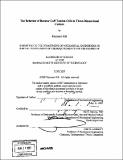The behavior of rotator cuff tendon cells in three-dimensional culture
Author(s)
Gill, Harmeet (Harmeet Kaur)
DownloadFull printable version (3.158Mb)
Other Contributors
Massachusetts Institute of Technology. Dept. of Mechanical Engineering.
Advisor
Myron Spector.
Terms of use
Metadata
Show full item recordAbstract
The rotator cuff is composed of the supraspinatus, infraspinatus, subcapularis, and teres minor tendons. Rotator cuff injuries are common athletic and occupational injuries that surgery cannot fully repair. Therefore tendon tissue engineering can provide alternatives to surgical solutions. Tendons are composed of parallel lines of bundles of collagen fibers and fibroblasts called fascicles and a glycoprotein, superficial zone protein (SZP), which is expressed by the gene, proteoglycan 4 (PRG4) may play a role in joint and intrafascicular lubrication. Studies have shown that a smooth muscle actin isoform (SMA), which plays a role in the contraction of smooth muscle cells, is expressed in the rotator cuff tendon cells. Previous investigations have been conducted to study PRG4 expression and distribution in different regions of the infraspinatus (ISP) tendon. The aim of this study was to investigate the behavior of adult goat ISP tendon cells and bovine bone marrow-derived mesenchymal stem cells (BMSCs) cultured in three-dimensional pellets in chondrogenic (CM), expansion (EM), and tenogenic media(TM). (cont.) The focus was on the effects of such growth factors as TGF-[beta]1 and hormones such as dexamethasone and various culture methods, such as the use of 96-well plates and 15 ml tubes, on the ISP tendon cells' and BMSCs' cell proliferation, chondrogenesis, and expression of PRG4 and SMA. ISP tendon cells and BMSCs were obtained from five adult Spanish goats ranging. After 14 days, the pellet cultures were analyzed using Safranin-O staining and immunohistochemical staining for SZP and SMA. The biochemical contents of the cell pellet cultures were also evaluated using a DNA assay on days 0 and 14 and a GAG assay on day 14. It was found that CM, containing TGF-[beta]1 and dexamethasone, induced the most cell proliferation and chondrogenesis. SZP was expressed in all of the ISP tendon cells pellet cultures that were cultured in tubes. In comparison to the larger CM-pellets, the ISP tendon and BMSC EM- and TM- pellets cultured in tubes had higher percentages of SMA present. However SMA was also expressed in the CM-pellets cultured in the 96-well plates. (cont.) The results of our study showed that environmental differences can change SMA expression. Further investigations on tendon cells and the effects of growth factors, bone morphogenetic proteins (BMPs), and culture methods on the cell proliferation, chondrogenesis, and SZP and SMA expression need to be conducted.
Description
Thesis (S.B.)--Massachusetts Institute of Technology, Dept. of Mechanical Engineering, 2007. Includes bibliographical references (leaves 37-41).
Date issued
2007Department
Massachusetts Institute of Technology. Department of Mechanical EngineeringPublisher
Massachusetts Institute of Technology
Keywords
Mechanical Engineering.